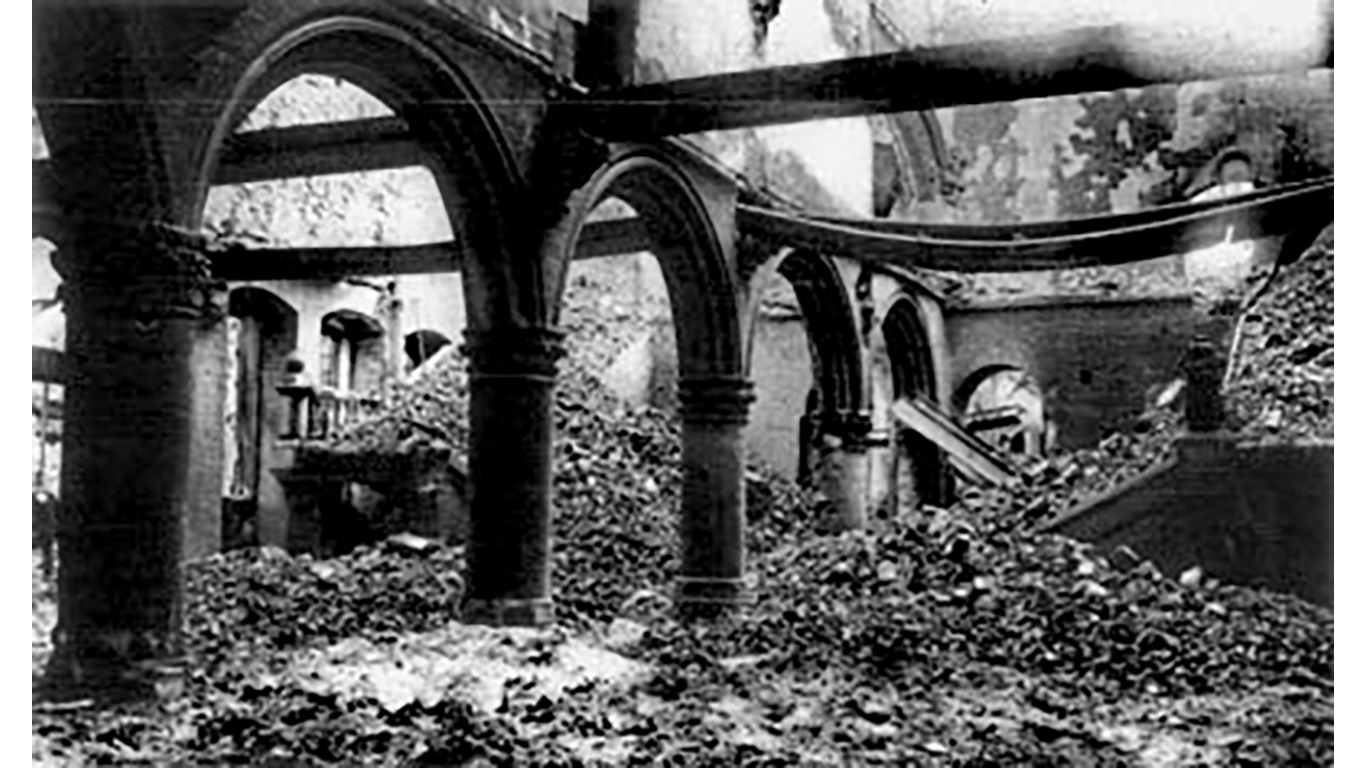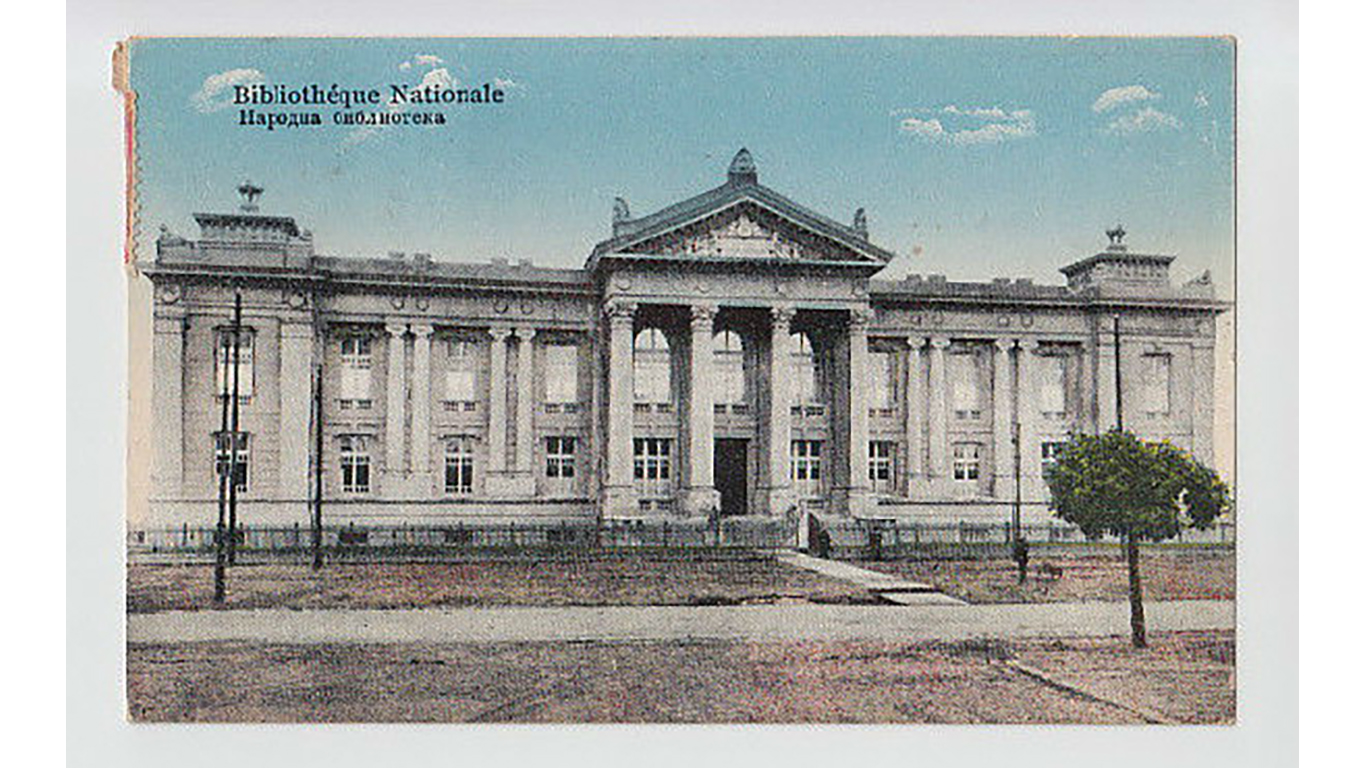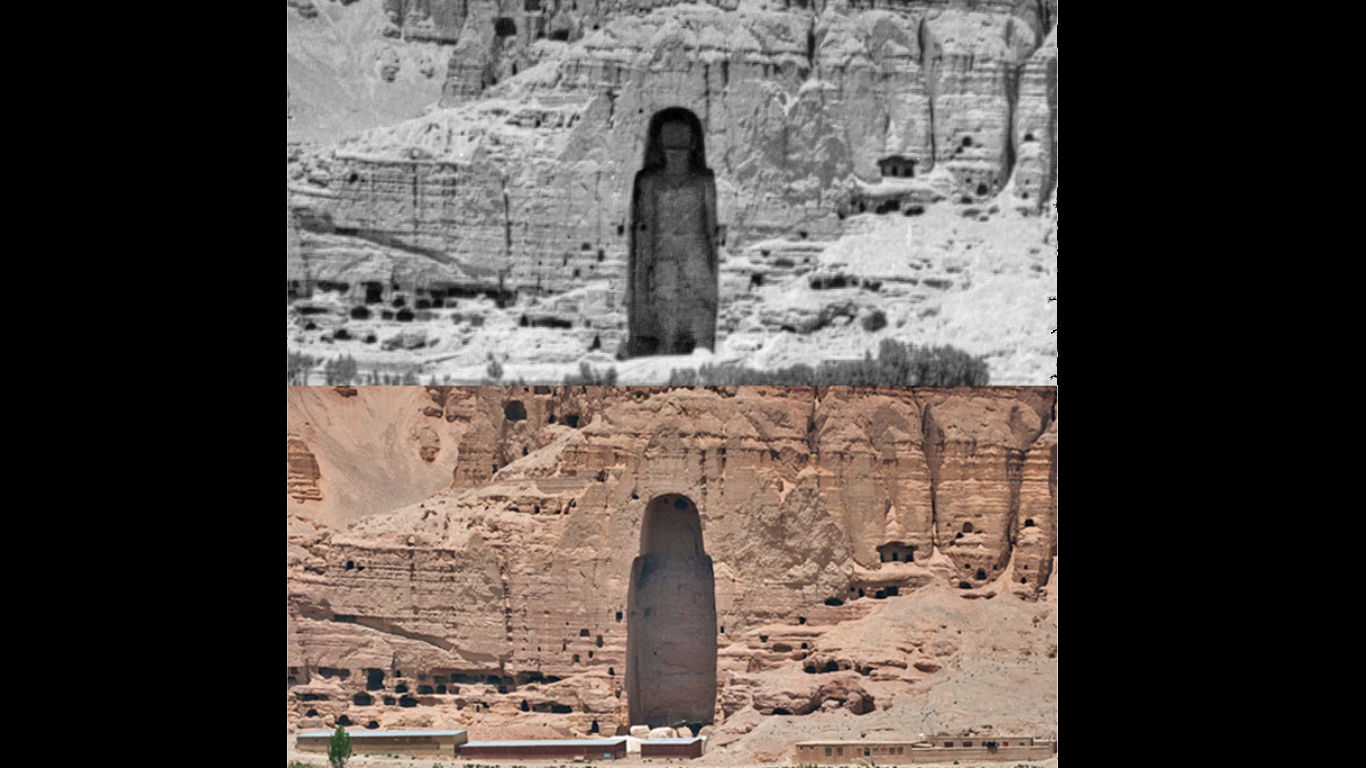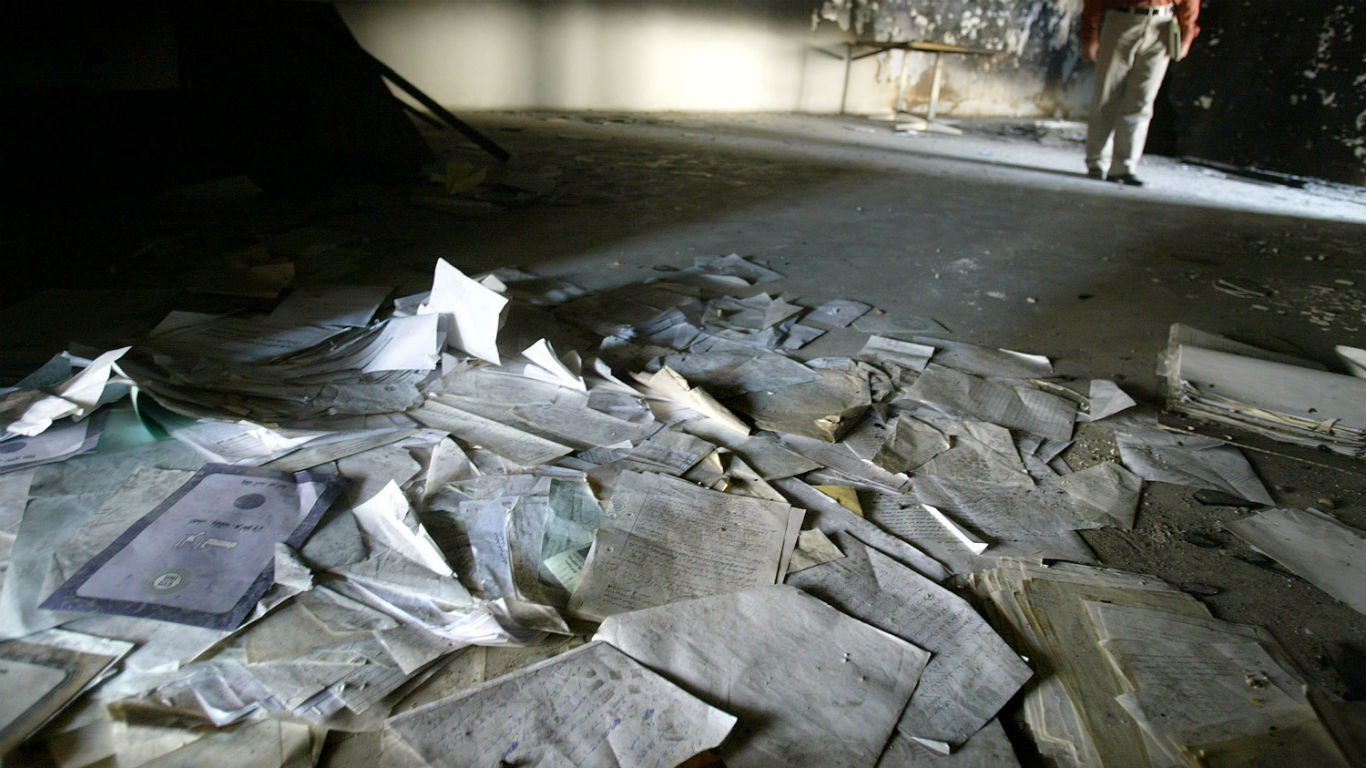Special Report
25 Irreplaceable Cultural Treasures Destroyed Forever by War

Published:

The destruction of cultural artifacts, heritage sites, and historical records such as temples, statues, museums, and libraries is among the many immeasurable tragedies of war.
While cultural sites are often inadvertently destroyed during bombings, it is also common for these symbols and heritage sites to be targeted during war. For example, it was Hitler’s decision that the former Kingdom of Yugoslavia should not exist as a state that led to the complete destruction of The National Library of Serbia in 1941.
More recently, numerous ancient monuments and temples have been destroyed by the Islamic State group (IS) because they were determined to be un-Islamic.
Countless artifacts and historical sites of cultural significance have been destroyed during wars and violent conflicts. 24/7 Tempo selected 25 notable examples from the mid-19th century to World War II through the present day. (These were the 18 biggest battles of World War II.)
Click here to see 25 cultural treasures destroyed forever by war
1. The Porcelain Tower, Nanjing, China
> War / conflict: The Taiping Rebellion, 1856
The Porcelain Tower of Nanjing was considered to be one of the Seven Wonders of the Medieval World. It was commissioned by the Ming Emperor Yongle in 1412, and construction took more than 17 years. The tower reportedly stood 259 feet tall and was almost 100 feet wide at its base. The walls of the pagoda were made of white porcelain bricks. It was destroyed in 1856 by rebels fighting the Qing Dynasty.
[in-text-ad]
2. The Old Summer Palace, Beijing, China
> War / conflict: Second Opium War, 1860
The Old Summer Palace in Beijing was built in the 18th and early 19th centuries and served as the primary quarters for members of the Qing Dynasty. The palace was known for its splendid gardens — it was called “Versailles of the East” — and was noteworthy for blending ancient Chinese landscape techniques with Western architecture. The palace was destroyed by colonial powers France and Great Britain in 1860 during the Second Opium War. What remains from the palace is now a park.

3. Old Town of Warsaw, Warsaw, Poland
> War / conflict: WWII, 1939-1944
Warsaw was one of many of the world’s capital cities that suffered greatly during World War II. After Nazi Germany overran Poland in 1939, the occupiers gradually destroyed the city, including its historic old town and market. After the German put down the Warsaw Uprising in the summer of 1944, they razed the old town.

4. Christchurch Greyfriars, London, England
> War / conflict: WWII, 1940
Christchurch Greyfriars was built as a Franciscan church in 1225, and the original house of worship was the final resting place of four queens. It was consumed by the Great Fire of London of 1666 and rebuilt by the famous architect Sir Christopher Wren in 1704. Christchurch Greyfriars was nearly fully destroyed by bombs during the Blitz by Nazi Germany in 1940. Only the tower and outer walls of the church remained after the bombing. The church was never rebuilt, and a rose garden now occupies its site.
[in-text-ad-2]
5. St. Michael’s Old Cathedral, Coventry, England
> War / conflict: WWII, 1940
Coventry was among the most severely bombed cities in England during WWII, and St. Michael’s Old Cathedral was one of the main targets of Nazi bombing in 1940. St. Michael’s was a gothic treasure built in the late 14th and early 15th centuries. During the Blitz in November 1940, Luftwaffe bombers destroyed the church, leaving only the spire, tower, and outer walls. The church was not rebuilt, but another church was constructed next to it and consecrated in 1962.

6. Leuven University Library, Leuven, Belgium
> War / conflict: WWII, 1940
The Leuven University Library in Leuven, Belgium, has the unfortunate distinction of being destroyed twice. The 17th-century book repository was demolished the first time in August of 1914 in the early stages of World War I by the German Army, who set fire to the town of Leuven. The library was rebuilt only to be leveled by the Nazis in 1940 during WWII. Belgium painstakingly rebuilt the library after the war.
[in-text-ad]

7. The National Library of Serbia, Belgrade, Serbia
> War / conflict: WWII, April 6, 1941
The National Library of Serbia, founded in 1832, was completely burned during WWII in the bombing of Belgrade by the Nazis on April 6, 1941. It was reportedly the only library destroyed on purpose in WWII. Hitler’s decision was based on his position that the former Kingdom of Yugoslavia should not exist as a state.
Much of the library’s holdings were destroyed, including 1,300 medieval manuscripts, more than 300,000 books printed in Serbia between the 15th and 17th centuries, 2,000 letters by distinguished Serbian and South Slovac people, as well as Ottoman manuscripts, newspapers, engravings, and maps documenting hundreds of years of history. The bombing also destroyed 8,000 structures in the city and killed 4,000 people.

8. Royal Opera House, Valletta, Malta
> War / conflict: WWII, April 27, 1942
Malta, located between Italy and Libya, played a geographically pivotal role in the Mediterranean Sea during WWII. The island came under aegis of the British Empire in the 19th century and became a key port for the Royal Navy. During WWII, Malta was attacked frequently by German bombers. In 1942, the Luftwaffe bombed the city of Valletta, and during the attack they destroyed the 19th-century Royal Opera House. Eventually, the Maltese built an open-air theater that opened in 2013.
9. Kaiser Wilhelm Memorial Church, Berlin, Germany
> War / conflict: WWII, 1943
The Kaiser Wilhelm Memorial Church in Berlin was built in a neo-Romantic style as an expression of nationalist pride in honor of Germany’s first kaiser, Wilhelm I, in 1895. It was destroyed by Allied bombing during WWII, and the victorious Allies refused to rebuild it because of its association with German nationalism.
[in-text-ad-2]

10. The Frauenkirche, Dresden, Germany
> War / conflict: WWII, 1945
The firebombing of Dresden, Germany by Allied bombers in February 1945, immortalized in the Kurt Vonnegut book “Slaughterhouse-Five,” devastated a city famous for its Baroque architecture. Its most famous structure was the Lutheran church Frauenkirche, a symbol of suffering that was completely restored in 2005. Other cultural institutions damaged or destroyed were the Zwinger art museum and the Juedenhof palace. Among the artistic treasures lost in the raid were “The Stone Breakers” by Gustave Courbet (1849) and “Danae” by Gilles Backereel (1619/1620).

11. Historic Tokyo, Tokyo, Japan
> War / conflict: WWII, 1945
What the massive earthquake of 1923 did not destroy in Tokyo, American bomber planes did during WWII. Incendiary bombs and napalm set off massive fire storms that gutted Japan’s capital in March of 1945, killing 100,000 people, and wiping out historic Tokyo.
12. Vijećnica (City Hall) of Sarajevo, Sarajevo, Bosnia
> War / conflict: Bosnian War, 1992
First opened in 1896, Vijecnica of Sarajevo was converted in 1949 into the National Library of Bosnia. The library, along with nearly 2 million books, was burnt to the ground during the Bosnian war in August 1992. The library’s collection included rare documentation of life under the Ottoman and Austro-Hungarian empires.
[in-text-ad]
13. Mehmed Pasha Kukavica Mosque, Foča, Bosnia and Herzegovina
> War / conflict: Bosnian War, 1993
The 18th-century Mehmed Pasha Kukavica Mosque in Foča, Bosnia and Herzegovina, is a cultural vestige of the Ottoman Empire, which held sway over the Balkans until the early 20th century. The mosque was almost destroyed during the Bosnian War in the 1990s, but the structure is being restored to preserve Muslim culture in the region.
14. Ferhat Pasha Mosque, Banja Luka, Bosnia and Herzegovina
> War / conflict: Bosnian War, 1992
Banja Luka, the second largest city in Bosnia-Herzegovina after Sarajevo, was the site of some of the worst human rights abuses during the Bosnian War. In addition to the forced displacement of the non-Serbian population and ethnic cleansing carried out during the conflict, objects and sites of cultural significance to religious minorities were deliberately destroyed. The UNESCO-designated cultural heritage site Ferhad Pasha Mosque was among several 16th century mosques destroyed by Serb forces in the city.

15. Buddhas of Bamiyan, Bamiyan, Afghanistan
> War / conflict: War in Afghanistan, 2001
The Buddhas of Bamiyan, Bamyan, Afghanistan, were carved into a sandstone cliff in the sixth century. The Buddha monuments were the tallest Buddhas in the world, with the tallest Buddha standing at 170 feet. It had been a holy site for monks since at least the early seventh century. In 2001, the Taliban, under the direction of Mullah Mohammed Omar, ordered their destruction because they were considered idolatrous statues. It took the Taliban 25 days to destroy the statues, using tanks, artillery shells, and dynamite.
[in-text-ad-2]

16. National Library, Baghdad, Iraq
> War / conflict: Iraq War, 2003
The National Library in Baghdad, Iraq, which housed millions of books, manuscripts, and stone tablets from antiquity, was plundered by those loyal to Saddam Hussein in April 2003, and the repository was set on fire. Lost forever were irreplaceable artifacts from the ancient Sumerian, Babylonian, and Assyrian civilisations.

16. Sidi Sha’ab Mosque, Tripoli, Libya
> War / conflict: Islamic sectarian violence, 2014
The Sidi Sha’ab Mosque in Tripoli, Libya’s capital city, was named after a 16th century scholar, a Sufi Muslim. His tomb was housed in the mosque, which was an important religious center for the Sufi community. Salafi Muslims razed the mosque in August of 2012, following rising tensions between Sufis and Salafis after the 2011 Arab Spring.
[in-text-ad]
17. Apamea Historical Sites, Apamea, Syria
> War / conflict: Syrian Civil War, 2011-2016
The Apamea Historical Sites in Apamea, Syria, were among the most visited archeological sites in the Middle East — and the city of Apamea is awash in history. It was once the home of the Seleucid Empire, later occupied by the Roman Empire, and the Crusaders used it as a base. Apamea was known for its paved streets and splendid mosaics. Unfortunately, the battles during the Syrian Civil War have devastated the historical site and many of its treasures have been plundered.
18. Omari Mosque, Daraa, Syria
> War / conflict: Syrian Civil War, 2013
The Omari Mosque in Daraa, Syria, goes back to the beginning of Islam, in the seventh century. It is one of the places where the Syrian revolution began in 2011. In April 2013, the Syrian government destroyed the minaret, one of the oldest in the Middle East. The mosque itself was also damaged by shelling from the Syrian military.
19. Museum of Islamic Art, Cairo, Egypt
> War / conflict: Car bomb, Jan. 24, 2014
A car bomb detonated on Jan. 24, 2014, collapsing ceilings and blowing out windows in Cairo’s Museum of Islamic Art. The museum was not destroyed but extensively damaged, affecting 20% to 30% of the priceless artifacts housed there. The museum is widely regarded as one of the most important archives of Islamic history.
[in-text-ad-2]

20. Lions of Hadatu, Ar-Raqqah, Syria
> War / conflict: ISIS conquest, 2014
The Lions of Hadattu, massive images of gatekeeping lions made from basalt, date from the eighth century B.C. The lions had guarded the entrance to a palace, long since destroyed, of an Assyrian monarch. Two of the surviving lions were on display in a park until the Islamic State destroyed them with bulldozers in 2014 after ISIS captured the region.
21. The historic district of Sana’a, Sana’a, Yemen
> War / conflict: War in Yemen, 2015
The old section of Sana’a in Yemen, which has been inhabited for about 2,500 years, is a UNESCO World Heritage Site. It was famous for its warrens of mosques, multi-story tower homes, and bathhouses behind partially preserved city walls. The name Sana’a means “fortified place.” The ongoing civil war in Yemen has devastated this part of the capital city. A Saudi-led airstrike hit the old city in September 2015 and destroyed many of the UNESCO sites.
[in-text-ad]
22. Great Mosque of Aleppo, Aleppo, Syria
> War / conflict: ISIS conquest, 2015
The Great Mosque of Aleppo was one of the iconic images of Syria. The UNESCO World Heritage Site was housed inside the walls of the old city of Aleppo and was said to contain the remains of Zechariah, the father of John the Baptist. The mosque’s minaret, dated from the 11th century, was destroyed during the Syrian Civil War in 2013. Other parts of the mosque were badly damaged by gunfire and bombs. Both sides blamed each other for the destruction of the mosque. Priceless artifacts were reportedly looted.
23. Al-Mahdi Mosque, Sana’a, Yemen
> Destroyed: War in Yemen, 2015
Another cultural victim of the civil war in Yemen was the Al-Mahdi Mosque in the capital city of Sana’a. The mosque was a UNESCO World Heritage Site and was known for its bright white dome and finely detailed carvings. The place of worship was attacked and destroyed as part of an airstrike that was carried out by a Saudi Arabia-led coalition in March of 2015.
24. Temple of Bel, Palmyra, Syria
> War / conflict: ISIS conquest, 2015
Another cultural casualty of ISIS was the Temple of Bel in Palmyra in Syria. The religious site was built in the first century and was dedicated to the Mesopotamian god Bel. Among the temple’s features were 1,000 columns, 500 tombs, and a Roman aqueduct. Islamic State fighters blew up the site in 2015. UNESCO, the UN cultural arm, condemned the act as a war crime intended to expunge Syria’s cultural diversity.
[in-text-ad-2]
25. The Gates of Nineveh, Nineveh, Iraq
> War / conflict: ISIS conquest, 2016
The imposing Gates of Nineveh guarded the most populous city in ancient Assyria, which was founded in the seventh century B.C. Two of these gates were destroyed by ISIS in 2016. Before the destruction of the Islamic State’s caliphate last year, the group eradicated many historic mosques, churches, and shrines in Iraq and Syria because they viewed artifacts that predated Islam as sacrilegious.
Start by taking a quick retirement quiz from SmartAsset that will match you with up to 3 financial advisors that serve your area and beyond in 5 minutes, or less.
Each advisor has been vetted by SmartAsset and is held to a fiduciary standard to act in your best interests.
Here’s how it works:
1. Answer SmartAsset advisor match quiz
2. Review your pre-screened matches at your leisure. Check out the advisors’ profiles.
3. Speak with advisors at no cost to you. Have an introductory call on the phone or introduction in person and choose whom to work with in the future
Thank you for reading! Have some feedback for us?
Contact the 24/7 Wall St. editorial team.